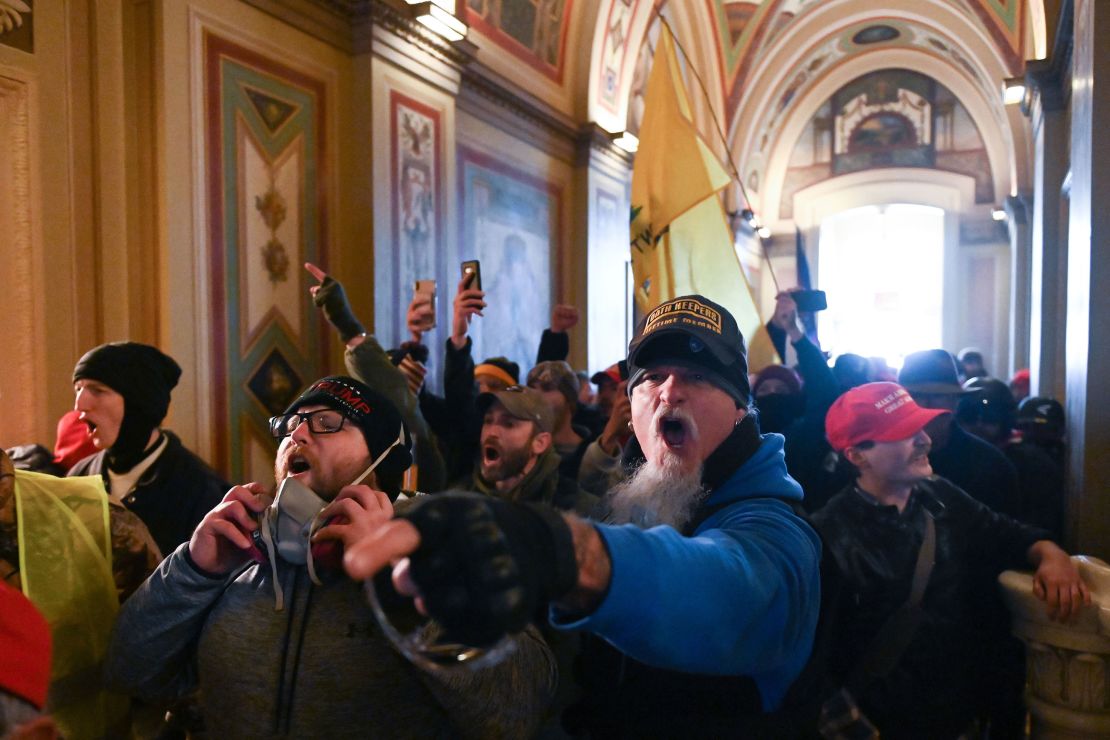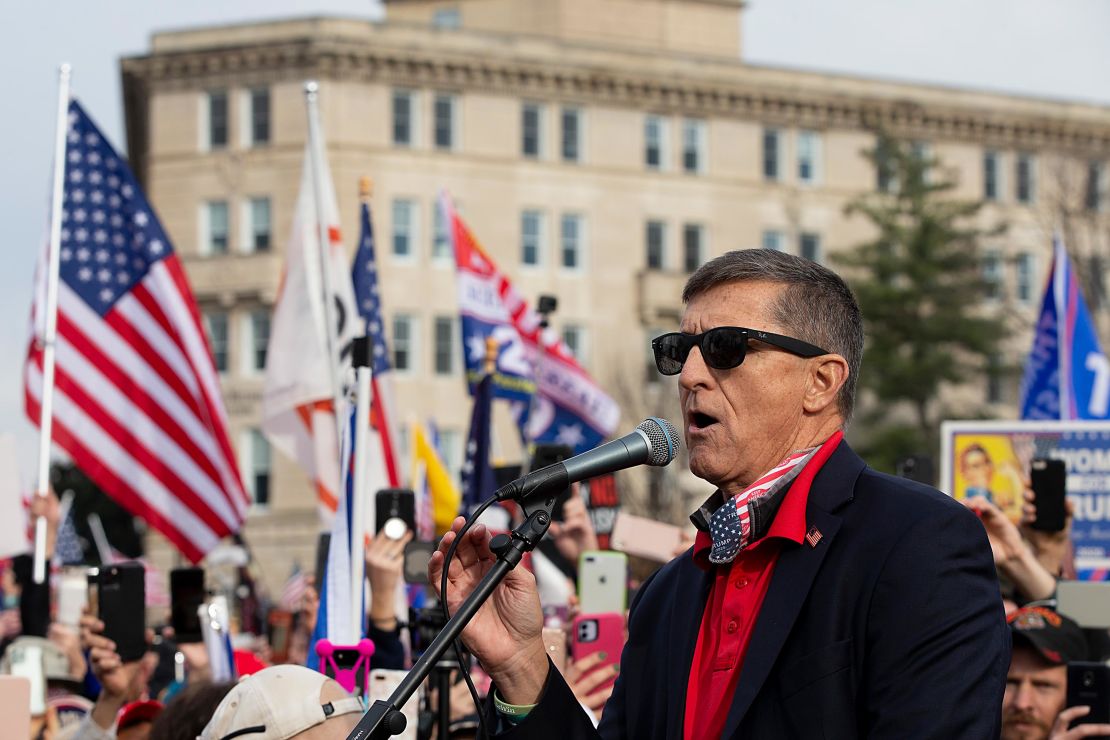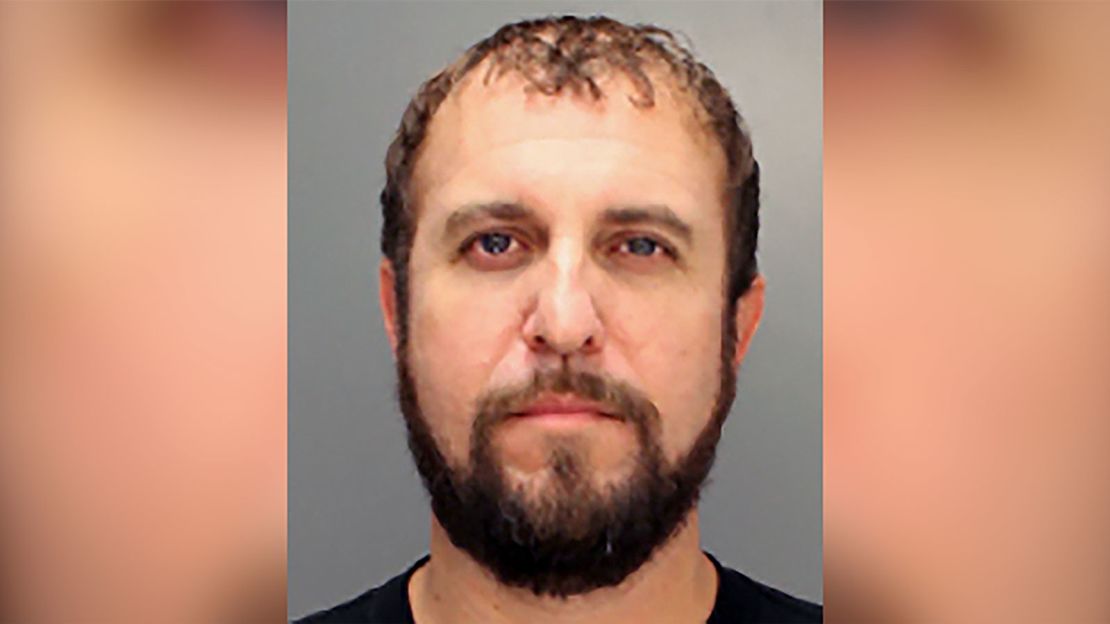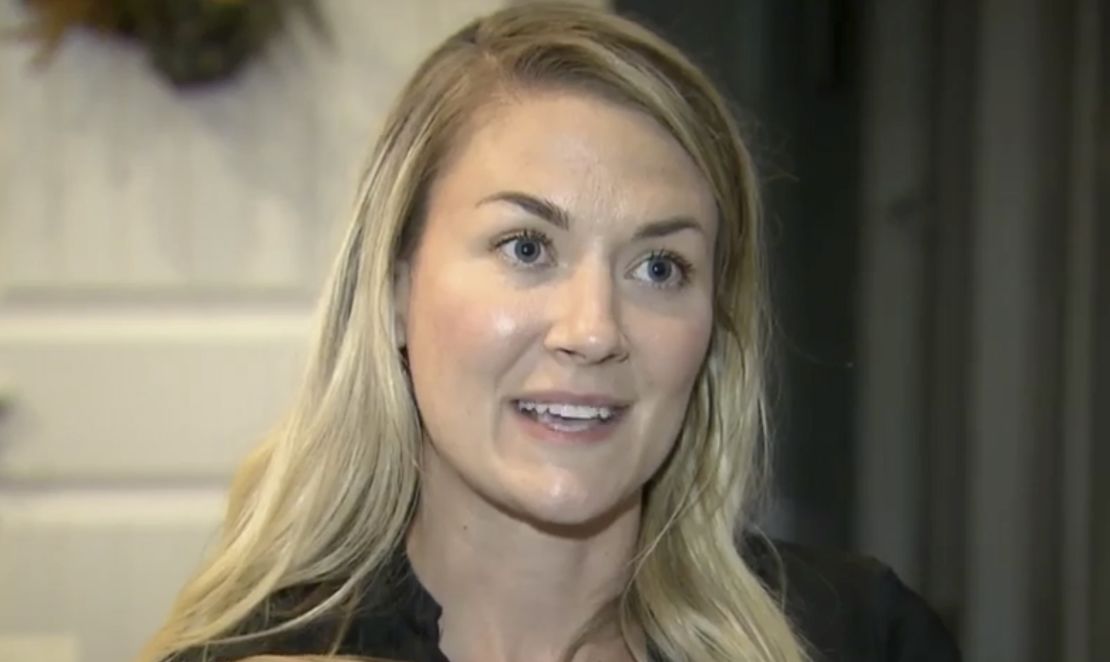Among the mob of extremists and Trump supporters that invaded the US Capitol last week in a deadly riot were former members of the very institution that is supposed to protect America from invasion: the US military.
They included 35-year-old Ashli Babbitt, an Air Force veteran who’d become infatuated with the QAnon conspiracy theory and on Wednesday was fatally shot by US Capitol Police as the mob tried to force its way toward the House chamber.
They included Larry Rendell Brock – a 53-year-old retired Air Force Reserve officer from Texas – who could be seen roaming the Senate chamber sporting a military helmet, green tactical vest and black-and-camo jacket while clutching a white flex cuff, which is used by law enforcement to restrain or detain subjects. He’s been charged with knowingly entering a restricted building without lawful authority, and violent entry and disorderly conduct, according to the Justice Department.

And attending the demonstrations that day was Joshua Macias, 42, a six-year Navy veteran from Virginia and co-founder of the group Vets for Trump who had recently been released from jail. On January 5 – the day before the siege – Macias appeared in a Facebook live video with a Virginia state senator; he says he did not enter the building the next day.
“The enemy is here, it’s not just at the gate,” Macias said in the now-removed video, according to The Washington Post. “It’s within, we see it everywhere.”
The radicalization of military veterans has long worried experts who monitor extremism online and elsewhere. And though it isn’t known whether soldiers and veterans are disproportionately vulnerable to radicalization, their association with extremist groups has been enough of a concern over the years for hate-group watchers to study the matter and lobby Congress to take action to counter it.
In February, the Southern Poverty Law Center and other groups urged the US House Armed Services Committee ensure the military branches vet enlistees for signs of white nationalistic beliefs, such as by reviewing their social media accounts, creating a tattoo database and performing psychological screenings.
“It was well-received, but nothing really changed,” Lecia Brooks, chief of staff at the Southern Poverty Law Center, told CNN.
The US Army is now taking steps to detect extremism in its ranks ahead of the January 20 inauguration of President-elect Joe Biden. In a written statement to CNN on Tuesday, an Army spokesperson said the branch is working with the Secret Service to determine whether there are soldiers who will be part of the National Guard contingent providing security at the inauguration who require additional background screening.
“The D.C. National Guard is also providing additional training to service members as they arrive in D.C. that if they see or hear something that is not appropriate, they should report it to their chain of command,” according to the statement.
Why extremists try to recruit veterans
From their tactical and organizational skills to their wide networks of friends with whom they served, veterans are an appealing group for extremists to recruit, experts say.
“The military is so beloved – the American public polls at something close to 75 percent confidence in the armed forces,” said Jim Golby, a University of Texas at Austin researcher who studies military and civilian relations. “And consider the way special ops are portrayed in popular culture, in movies. There is an identity that [extremist] groups want to have. They want to emulate the way military members dress, the way they carry weapons because that portrays an image of confidence and credibility.”
Indeed, mixed in with the motley crew of protesters and rioters on Wednesday was a body-armored band of Oath Keepers, an anti-government militia group intent on stoking civil war that claims to include many law enforcement members and military veterans.

Extremist groups play on veterans and service members’ deeply felt sense of patriotism to recruit them, said retired Army Lt. General David Barno, former head of Combined Forces Command-Afghanistan.
“For some of these groups, they clearly portray an idea of super patriotism – waving the American flag, saying we believe in the flag,” he said.
The groups, he said, also provide a sense of camaraderie and shared viewpoints.
“This connection … that’s one thing I know almost all veterans miss when they leave the military,” Barno said.
And veterans and service members follow leaders. When they see members of Congress – such as Georgia Rep. Marjorie Taylor Greene, who has embraced QAnon conspiracies, or Missouri Sen. Josh Hawley raising doubts about the legitimacy of the election – they can be swayed, he said.
“The military services will have to take a hard look at this,” said Barno, who is currently a visiting professor of strategic studies and senior fellow at the Merrill Center at the Johns Hopkins University School of Advanced International Studies. “The fact that there were officers and enlisted and retirees [at the Capitol siege] is jarring and shocking and appalling. And even if that was a small number of people, the question [for top brass] is how much a tip of the iceberg is that? How prevalent is this kind of extremist activity among members and veterans?”
There is scant data available on why, how and how often veterans are radicalized to believe extreme views, Golby said. There are several reasons for that, he explained.
It’s generally a challenge for researchers outside the military system to be allowed to survey active members. Active-duty members are always being surveyed about quality of life, their commanders and so on. “They [the Department of Defense] rightfully try to protect members from being overly surveyed,” Golby said.
And there’s also hesitation from active-duty members and veterans to be completely honest in surveys – just as it sometimes is when they are polled about suicide. If a service member or veteran admits to subscribing or leaning toward extremist ideology, will that disclosure hurt their military career or legacy?
And determining whom to poll in a population of 1.3 million active-duty personnel and approximately 18 million veterans is also tricky. Do you target Gulf War veterans? Iraq and Afghanistan war veterans? “But there’s no question that it should be done,” Golby said.
Retired Gen. Flynn evokes bloody Civil War battle

While the scale of radicalization in the military remains unclear, there is at least one decorated general who has embraced extremist views: Michael T. Flynn.
In July, the retired general and former national security adviser posted a short video of himself taking an oath and uttering a phrase – “Where we go one, we go all!”— associated with QAnon, an online movement that subscribes to the delusional belief that Trump is battling a cabal of Democrats and elitists who are pedophiles and worship Satan.
In December, Flynn – who was pardoned by Trump in November after his conviction of lying to the FBI about his conversations with a Russian diplomat – tweeted a press release from an Ohio organization calling on Trump to “immediately declare a limited form of martial law, and temporarily suspend the Constitution and civilian control of these federal elections, for the sole purpose of having the military oversee a re-vote.”
Martial law, which has been invoked only a handful of times in US history, essentially puts the military in charge of the government after a breakdown of civil order following a foreign attack or natural disaster.
On January 5 – a day before the insurrection at the US Capitol – Flynn gave a pep talk to Trump supporters laden with lies about a stolen election and violent imagery associated with war.
“In some of these states, we have more dead voters than are buried on the battlefields of Gettysburg,” he said. “Those of you who are feeling weak tonight, those of you that don’t have the moral fiber in your body, get some tonight because tomorrow, we the people are going to be here, and we want you to know that we will not stand for a lie.”
Last week, Twitter permanently banned Flynn and other high-profile Trump allies who have promoted QAnon.
Brock – the man in the green military helmet seen wandering the Senate floor clutching the zip-tie cuffs – was arrested Sunday and charged with knowingly entering a restricted building without lawful authority, according to the Justice Department.
Family members told the New Yorker his views had grown more extreme over the years, and more informed by white supremacy. Brock denied he holds racist views in an interview with the magazine, and repeated Trump’s groundless assertions of election fraud.
Macias – the veteran who shot the Facebook video – had been arrested on November 5 along with another man on suspicion of carrying unpermitted handguns in Philadelphia, where authorities say the men had traveled due to their concerns about “fake ballots.” Macias was released on November 26 after posting $75,000 of his $750,000 bail. Philadelphia prosecutors accused Macias of trying “to interfere with the counting of lawfully cast votes.”

Prosecutors now want Macias’ bail revoked.
“My office is prepared to argue that this defendant’s participation in the seditious, outrageous, and deadly invasion of the U.S. Capitol on [January 6] in order to help a criminal president remain in office unlawfully meets the definition of violating terms of bail,” said Philadelphia District Attorney Larry Krasner in a statement.
Macias, who says he has left the Vets for Trump group he co-founded, maintains that he did not enter the Capitol building, and so did not violate bail, his attorney, William J. Brennan, told the Washington Post.
Macias has a personal website that thanks supporters for raising $160,000 for his legal defense.
Another veteran, Emily Rainey, a former Army officer assigned to Fort Bragg in North Carolina, is under investigation by the US Army for her involvement in last week’s events.

Rainey led about 100 people from North Carolina to the demonstration, though she told the Associated Press she did not breach the building. Rainey, who resigned her post before the siege for unrelated reasons, posted a video in May of herself ripping down caution tape at a playground that was closed because of North Carolina’s coronavirus restrictions, according to CNN affiliate WRAL in Raleigh.
Brock, Macias and Rainey and their attorneys could not be reached for comment.
Capitol Hill officer killed also a veteran
Some experts caution that it is critical not to paint a broad brush when trying to learn why some veterans are drawn to Trump, extremist views or nationalist movements.
“I would challenge the premise that veterans are any more susceptible to propaganda than anyone else,” said Paul Rieckhoff, the founder and former CEO of the Iraq and Afghanistan Veterans of America. “We are a slice of the population.”
He added: “Remember that the Capitol Hill cop who died was a veteran,” referring to Brian Sicknick, who succumbed to injuries he suffered in the riot.
Consider the lawmakers who are veterans, trying to make their way to safety: Rep. Ruben Gallego, a former Marine; Rep. Jason Crow, a former Army Ranger; Sen. Tammy Duckworth, a retired Army National Guard lieutenant colonel who suffered severe wounds in Iraq.
When it comes to the attack on the Capitol, those who perpetrated the siege who happen to be veterans are going to make more headlines because of their past service. It’s a quick – and sometimes too easy – way to qualify them, Rieckhoff said.
“Ashli Babbitt was a veteran, but she was a lot of other things. There are a million factors in someone’s life that leads them down the path she took,” he said.
“It’s dangerous waters right now because we (veterans) are fighting stereotypes,” he noted. “When we talk about recruitment of veterans to these groups, I think what that says simply is that veterans are powerful, period.”
Conspiracy theories abound
Thomas Speciale, an Army Reservist who served in Afghanistan, was at the Capitol on Wednesday, but said he stayed outside.
Speciale, who made an unsuccessful run for the Senate and has served as the national spokesman for Vets for Trump, told CNN that he doubted Trump supporters started the assault on the building – breaking windows and charging inside. That explanation is too simple for him. There must be something more sinister at work, he asserted.
“I believe there were professional instigators, professional agitators,” he claimed. “The enemies of the Trump movement want us to fight with the cops.”
Vlad Lemets, a US veteran from Florida and the director of Vets for Trump, said it had members of the organization at the Capitol. He stressed that he wasn’t there.
The group has what he estimates are over a million members and its communication is run mostly through Facebook. Lemets had trouble a few years ago when Macedonian trolls hijacked the group’s page and spread information intended to rile up posters. But, still, today, back in their American hands, the page includes posts that have been flagged by Facebook for falsehoods.
Lemets disagreed that Trump has been lying about the election results or anything else. Rather, he insisted, Trump has delivered on vows he made to Americans when he launched his campaign for the White House.
“Promises made, promises kept,” said Lemets, a Florida sometime-real estate agent who was born in Russia and said he served in the Iraq War. He asserted that one of the big reasons his organization’s followers like Trump is because Trump focused on border security.
“A lot of veterans retired from service – we find ourselves in government jobs, police, and border patrol,” he said. “In border patrol, they say they went to fight [in Iraq and Afghanistan] in what were civil wars. We were stuck in the middle of other people’s civil war. They find that the same people they are trying to kill over there are coming across the border to kill them.”
Lemets, echoing false claims from Trump in 2018, believes that Middle Easterners are sneaking across the border to commit violence.
Trump claimed that “unknown Middle Easterners” were coming into the US from Central America in a migrant caravan.
Pressed by CNN’s Jim Acosta for proof of that, Trump answered, “there’s no proof of anything, but they could very well be.”
Veterans targeted by foreign trolls
Kristofer Goldsmith, the former chief investigator for the Vietnam Veterans of America, spent years researching how disinformation – including Pro-Trump propaganda – has targeted veterans.
That project began when he noticed a fake Facebook page for the VVA had been set up – he would later learn by digital trolls in Bulgaria and other countries – to post fake information targeting veterans with anti-democracy propaganda. The messages were intended, Goldsmith said, to provoke anger.
Goldsmith wrote a 200-page paper about his findings, including that foreign admins at one point controlled the Facebook page Vets for Trump
One of the most powerful and popular memes shared among veterans online during the last several years, Goldsmith said, was a doctored image of four female Democratic representatives – known as the Squad – posing in front of an ISIS flag, an “impeach Trump” sign and portrait of Osama bin Laden.
“I was shocked to see – if you look at comments – just how many people believed that was real,” he said.
The Vets for Trump page is today filled with disinformation and falsehoods about the presidential election.
In 2018, Goldsmith tried to call national attention to the problem in a Wired op-ed and said the VVA asked the US Department of Veterans Affairs to take a more proactive role in helping veterans disseminate fact from fiction.
The VA has not done that, Goldsmith said.
Asked whether the VA has taken action to help veterans decipher propaganda online or to improve their media literacy, spokesperson Christina Noel emailed, “Policing or regulating online content is not part of the department’s mission.”
Goldsmith understands firsthand how easy it is to believe in what others might see as crazy.
When Goldsmith came home from fighting in Iraq, he was lost. He was 16 when 9/11 happened, inspiring him to enlist the first chance he got. He was soon deployed to Iraq.
“I turned 20 sitting on top of the Sheraton hotel in Baghdad watching car bombs,” he said.
The trauma he experienced at war, especially one itself started by the misinformation floated by the US government about Saddam Hussein having weapons of mass destruction, made him want to find the “real” truth. Goldsmith was drawn in by a trilogy of films that present a myriad of government conspiracy theories. He spent what little money he had burning CDs of the films and putting them in random people’s mailboxes.
“Next thing I know I’m out spray painting on my town’s train station ‘Ron Paul Revolution,’” he said, inspired by Paul’s libertarian takes and the former politician’s rejection of the Iraq war.
“I thought it was my duty to spread the truth and fight for what was right and just,” Goldsmith said. “But I didn’t have great media literacy. I didn’t know how to weigh evidence. When I realized that the war I was fighting wasn’t popularly supported, it made me feel like I’d lost my belief system.”
Deeply concerned, his mother intervened and pushed him toward the VA, where he underwent helpful therapy sessions and was eventually able to direct his drive and intellectual curiosity toward becoming an investigator at the Vietnam Veterans of America.
“I was given access to mental health care that helped me let go of anger and regret,” he said, “the emotions that can drive some of what we saw Wednesday.”










